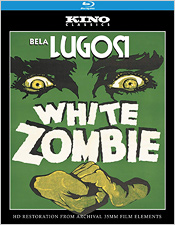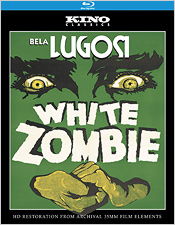White Zombie (Blu-ray Review)

Director
Victor HalperinRelease Date(s)
1932 (January 29, 2013)Studio(s)
United Artists (Kino Classics)- Film/Program Grade: C
- Video Grade: B-
- Audio Grade: B-
- Extras Grade: B-
Review
Nowadays, it’s hip to be undead. Thanks to the runaway success of the comic book-turned-television series The Walking Dead, zombies are back in style. Not wanting to miss the boat, Kino Classics has reached all the way back to 1932 for a new Blu-ray issue of the very first feature-length zombie film: White Zombie.
White Zombie tells the tale of Madeline (Madge Bellamy) and Neil (John Harron), a young couple who are to be married on the Haitian estate of Charles Beaumont (Robert Frazer). Beaumont’s offer of his estate for their wedding, however, is just a ruse. He wants Madeline all for himself. He enlists the aid of “Murder” Legendre (top-billed Bela Lugosi, fresh off 1931’s Dracula), owner of a nearby mill where all of the workers just happen to be zombies he has created! The sinister pair carries out their plan just after the wedding has concluded. Madeline is slipped the potion which will turn her into a zombie. When she collapses, Neil believes she has died. Stricken with grief, he mourns for his bride, but the missionary Dr. Bruner (Joseph Cawthorn) convinces him that something more nefarious may be afoot. As the two race to rescue Madeline, Beaumont begins to regret his agreement with Legendre, as her emotionless zombie state is not what he had imagined. Legrende reveals his true evil as the film reaches its climax in a short 67 minute running time.
This brisk and melodramatic adventure was produced by Edward Halperin and directed by Victor Halperin, two brothers who had collaborated on several films during the 1930s and 1940s. The screenplay was penned by Garnett Weston (The Great Train Robbery) based on the 1929 book Magic Island by William Seabrook. Shot independently on a small budget in only 11 days and released by United Artists, White Zombie is rather straightforward. Though the dialogue can be stilted at times, the film features some of the tropes of horror filmmaking that still exist today. In one scene, Madeline is shown in her lingerie in her bedroom, though there’s little point to the sequence beyond titillation. (This was pre-Code Hollywood, after all. The Motion Picture Production Code, introduced in 1930, wasn’t fully enforced until 1934.) The film is most enjoyable today on the merits of its historical significance, atmospheric sets, solid camera work, and Lugosi’s bold performance.
The movie has the first utterance of the word “zombie” in an American film, but wasn’t the first popular use of the term. Kenneth Webb’s Broadway play Zombie opened earlier in 1932, and may have inspired some of the themes in White Zombie. It’s worth mentioning, though, that the zombies in Halperin’s picture are portrayed differently from the image held by most fans today. The “modern” zombie took hold in pop culture thanks to George Romero’s Night of the Living Dead (1968) – although the term is never used in Romero’s film which prefers “ghoul” – and continues all the way through today’s popular Walking Dead series. Rather than the undead we all know, the zombies in White Zombie are derived from the Haitian tradition of stories where zombies are a metaphor for slavery. These zombies are undead but are used to work in fields and don’t wish to consume human flesh. In other zombie stories, the existence of the zombie is usually due to a scientific or mystic reason. White Zombie doesn’t definitively say where its zombies spring from, and gives evidence of both mystic and scientific origins. At points, it seems that Legendre’s zombies aren’t truly undead, but just in a death-like trance through the ingestion of a chemical. At other times, Legrende uses voodoo-like dolls created from candles to aid in the creation of a zombie, lending credence to a more supernatural explanation.
The film was a low-budget affair but it doesn’t always look the part due to the fact that it was shot on rented sets on the Universal lots. Therefore, you’ll see large and well-constructed locations from Universal’s own slate of horror films like Dracula and Frankenstein. With its additional set dressing, White Zombie has the look of a much bigger budgeted film. Arthur Martinelli also turned in superlative camera work. There are numerous shots done with strange angles through crypts or staircase bannisters. One long expository scene in the middle of the film between Bruner and Neil is done entirely in one continuous shot. Also, there are many close-ups on Lugosi’s eyes and hands which add an air of menace to the proceedings. These elements add to the overall dark atmosphere of the film which seems more sophisticated than the script would indicate.
Unfortunately, the inventive camera work and impressive sets didn’t seem to inspire most of the cast to rise above the bare minimum of what was expected of them. Other than Lugosi, the players are mostly sub-par. Bellamy and Harron were silent actors struggling to transition into talking pictures. They weren’t terribly successful. Based on their performances here, it’s not difficult to see why. They have almost no chemistry together and Bellamy in particular has a hard time emoting. The shift between her normal self and zombie state is not that different. Lugosi is the film’s strongest asset. His Legendre is evil through and through, but is deliciously captivating. He delivers his lines with relish and his wickedness flows off of the screen. He is aided by the excellent make-up work of Jack Pierce, who also worked on Frankenstein, The Wolf Man and The Mummy.
The picture quality on Kino’s Blu-ray release will be the subject of much debate. Thankfully, the film is presented in two very different prints. First is a digital restoration sourced from a 1960s 35mm print. There are still occasional blemishes, but overall, the restoration makes for a clean picture free of most scratches and specks. Blacks are deep and shadows are vivid. Quite simply, many will feel White Zombie has never looked as good. Purists may take another view, however. The digitally-restored presentation has removed the film’s grain structure, which lends it an artificial and “soft” quality. If this “too-clean” treatment isn’t for you, though, Kino has also included a “raw” transfer as one of the disc’s special features. The grain here is untouched, but the print is also clearly damaged in numerous places as well as noisy. As a result, it doesn’t make for a great viewing experience. Though this print is more authentic and free of digital enhancement, many viewers will likely opt for the more eminently watchable "restored" version.
The audio track is presented in mono. Both dialogue and music (including works from classical composers Mussorgsky, Liszt and Wagner) are generally clean and audible, although there are some imperfections. Taking into consideration both the age of the movie and its budget, however, that is to be expected. Alas, no subtitles have been provided on this release.
The remaining extras are decent, if slightly sparse. The best is the commentary by Frank Thompson. There are hardly any silent spots and he fills you in on many fascinating facts about the movie in a very engaging manner. He fairly and honestly analyzes the film’s strengths and weaknesses, which is always refreshing to hear in a commentary. And being that the film itself is only 67 minutes long, the commentary goes by quickly too. The only other two bonuses are a trailer from a 1950s re-release and a brief interview with Bela Lugosi done around the time of the film’s original release. They are both nice to have, with the interview being a particularly interesting look into movie marketing at the time. Neither adds much to the overall package, though.
If not for its historical significance as the first zombie film and Bela Lugosi’s performance, White Zombie probably would have faded into the recesses of time as an early “B” horror flick. If you’re a fan of the film or interested in the beginning of the zombie genre, though, you owe it to yourself to check out this Blu-ray. Due to its public domain status, White Zombie has been released numerous times before, but Kino’s BD is the best presentation of this landmark film on home video to date.
- Joe Marchese

